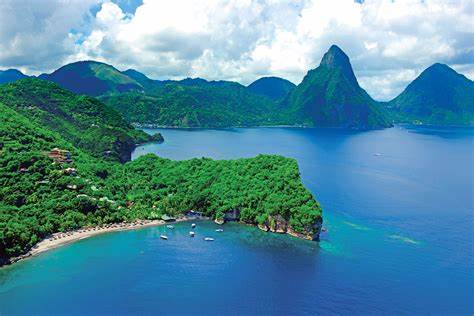
ANSE CHASTANET – SAINT LUCIA
Description
Anse Chastanet is a reef located in a marine protected area on the southwest coast of Saint Lucia. Considered one of the most beautiful reefs on the island, Anse Chastanet has also become one of the most popular scuba diving sites, thanks in part to the nearby hotels. The access areas to the reef are marked by a floating rope in four sections, accessible from the beaches of Anse Chastanet and Anse Mamin.
Zone 1, an integral part of the marine protected area, is the only zone where it is not necessary to use a dive flag or visibility marker. It is also the area where most visitors go snorkeling, including groups brought in by excursion boats. It consists mainly of numerous large rock formations encrusted with colorful sponges and a few corals.
Zone 2 is located in front of Anse Chastanet beach and is a seagrass bed.
Zone 3 is located before the right end of Anse Chastanet beach and consists of a few rocks of varying sizes in shallow water along the coast to the pier.
Zone 4 can be reached by walking to Anse Mamin beach and entering the water on the left side, near the rocky shore. This zone consists mainly of large soft coral gardens, with a few sponge-covered rocks and some hard corals.
The site is also close to some of Saint Lucia’s most popular attractions, including the Pitons, a UNESCO World Heritage Site, and Sulfur Springs, the sulfur springs of Qualibou.
Biodiversity
We observe a variety of marine landscapes, including seagrass beds, vast gardens of soft corals such as gorgonians, rocks covered with sponges such as the organ pipe sponge (Aplysina fistularis), as well as hard corals such as Neptune’s brain coral (Diploria labyrinthiformis) and elkhorn coral (Acropora palmata).
The reef is home to an impressive diversity of marine life, including more than 150 species of fish such as parrotfish (Scaridae), Atlantic sergeant majors (Abudefduf saxatilis), squirrelfish such as the red cardinalfish (Holocentrus rufus), Tibouche grunts (Haemulon chrysargyreum), needlefish (Belonidae), Caribbean trumpetfish (Aulostomus maculatus), peacock flounder (Bothus lunatus), Spotted knights (Equetus punctatus), flying gurnards (Dactyltopterus volitans), French angelfish (Pomacanthus paru), blue surgeonfish (Acanthurus coeruleus) and four-eyed butterflyfish (Chaetodon capistratus).
The reef is also home to various species such as the hawksbill turtle (Eretmochelys imbricata), crabs such as the warty spider crab (Mithrax spinosissimus), seahorses, sea urchins, and mollusks such as cuttlefish and octopus.
Near the shore, among the sea grass beds, it is common to see stingrays.
Ecotourism potential
The area around Anse Chastanet is part of the Soufriere Marine Management Area (SMMA) marine reserve, created in 1995 to preserve Saint Lucia’s magnificent coral reefs. Fishing is regulated in this area and boats are prohibited from entering.
It is one of Saint Lucia’s most popular tourist attractions, not only because of its beauty, but also because of its accessibility. It is located about an hour’s drive from Castries and Vieux-Fort. In addition, the reef is accessible from the shore, making it an ideal spot for snorkeling and scuba diving enthusiasts. The site is also close to many restaurants and iconic sites such as the Pitons, visible from the beach, as well as the sulfur springs of Sulphur Springs. The site is also close to hiking trails. For example, you can walk from Anse Chastanet Beach to Anse Mamin Beach via the coastal trail.
There are various transportation options for getting to Anse Chastanet: boat trip, car, taxi, or water taxi, the latter costing around $30 for a one-way trip. It is even possible to organize a tour with stops at other beaches in the area. You can also rent a small boat for a few hundred dollars for half a day or a full day.
Sources
Home – Anse Chastanet Resort – St Lucia Resorts
The Complete Guide To Anse Chastanet, St. Lucia | SANDALS
Anse Chastanet Snorkeling – What It’s Like, Where To Snorkel (tropicalsnorkeling.com)
Snorkeling à Sainte-Lucie | Les meilleurs spots de PMT à Sainte-Lucie (snorkeling-report.com)
List of Marine Fishes reported from Saint Lucia (fishbase.se)
Informations
-
Types de milieux
Baies -
Location
Saint Lucia (Chastanet)
